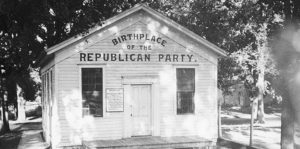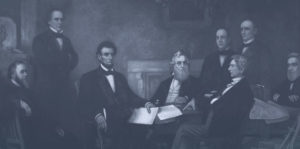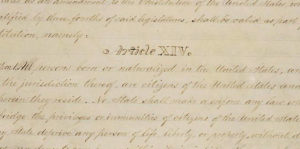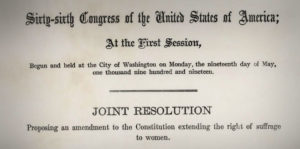The Republican Party was born in the early 1850’s by anti-slavery activists and individuals who believed that government should grant western lands to settlers free of charge. The first informal meeting of the party took place in Ripon, Wisconsin, a small town northwest of Milwaukee. The first official Republican meeting took place on July 6th, 1854 in Jackson, Michigan.

The name “Republican” was chosen because it alluded to equality and reminded individuals of Thomas Jefferson’s Democratic-Republican Party. At the Jackson convention, the new party adopted a platform and nominated candidates for office in Michigan.
In 1856, the Republicans became a national party when John C. Fremont was nominated for President under the slogan: “Free soil, free labor, free speech, free men, Fremont.” Even though they were considered a “third party” because the Democrats and Whigs represented the two-party system at the time, Fremont received 33% of the vote. Four years later, Abraham Lincoln became the first Republican to win the White House.

The Civil War erupted in 1861 and lasted four grueling years. During the war, against the advice of his cabinet, Lincoln signed the Emancipation Proclamation that freed the slaves.

The Republicans of the day worked to pass the Thirteenth Amendment, which outlawed slavery, the Fourteenth, which guaranteed equal protection under the laws, and the Fifteenth, which helped secure voting rights for African-Americans.
The Republican Party also played a leading role in securing women the right to vote. In 1896, Republicans were the first major party to favor women’s suffrage.

When the 19th Amendment finally was added to the Constitution, 26 of 36 state legislatures that had voted to ratify it were under Republican control.The first woman elected to Congress was a Republican, Jeanette Rankin from Montana in 1917.
Presidents during most of the late nineteenth century and the early part of the twentieth century were Republicans. The White House was in Republican hands under Presidents Eisenhower, Nixon, Ford, Reagan and Bush. Under the last two, Ronald Reagan and George H.W. Bush, the United States became the world’s only superpower, winning the Cold War from the old Soviet Union and releasing millions from Communist oppression.
Behind all the elected officials and the candidates of any political party are thousands of hard-working staff and volunteers who raise money, lick the envelopes, and make the phone calls that every winning campaign must have. The national structure of our party starts with the Republican National Committee. Each state has its own Republican State Committee with a Chairman and staff. The Republican structure goes right down to the neighborhoods, where a Republican precinct captain every Election Day organizes Republican workers to get out the vote.
Most states ask voters when they register to express party preference. Voters don’t have to do so, but registration lists let the parties know exactly which voters they want to be sure vote on Election Day. Just because voters register as a Republican, they don’t need to vote that way – many voters split their tickets, voting for candidates in both parties. But the national party is made up of all registered Republicans in all 50 states. They are the heart and soul of the party. Republicans have a long and rich history with basic principles: Individuals, not government, can make the best decisions; all people are entitled to equal rights; and decisions are best made close to home.
The symbol of the Republican Party is the elephant. During the mid term elections way back in 1874, Democrats tried to scare voters into thinking President Grant would seek to run for an unprecedented third term. Thomas Nast, a cartoonist for Harper’s Weekly, depicted a Democratic jackass trying to scare a Republican elephant – and both symbols stuck. For a long time Republicans have been known as the “G.O.P.” And party faithfuls thought it meant the “Grand Old Party.” But apparently the original meaning (in 1875) was “gallant old party.” And when automobiles were invented it also came to mean, “get out and push.” That’s still a pretty good slogan for Republicans who depend every campaign year on the hard work of hundreds of thousands of volunteers to get out and vote and push people to support the causes of the Republican Party.
